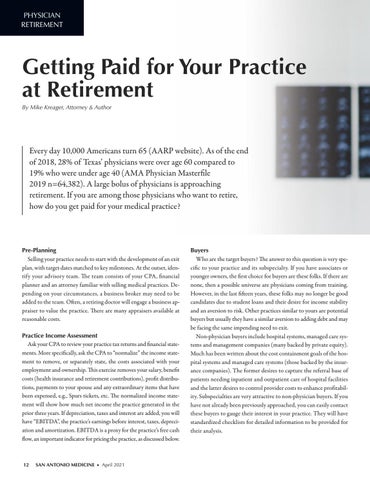PHYSICIAN RETIREMENT
Getting Paid for Your Practice at Retirement By Mike Kreager, Attorney & Author
Every day 10,000 Americans turn 65 (AARP website). As of the end of 2018, 28% of Texas’ physicians were over age 60 compared to 19% who were under age 40 (AMA Physician Masterfile 2019 n=64,382). A large bolus of physicians is approaching retirement. If you are among those physicians who want to retire, how do you get paid for your medical practice?
Pre-Planning Selling your practice needs to start with the development of an exit plan, with target dates matched to key milestones. At the outset, identify your advisory team. The team consists of your CPA, financial planner and an attorney familiar with selling medical practices. Depending on your circumstances, a business broker may need to be added to the team. Often, a retiring doctor will engage a business appraiser to value the practice. There are many appraisers available at reasonable costs. Practice Income Assessment Ask your CPA to review your practice tax returns and financial statements. More specifically, ask the CPA to “normalize” the income statement to remove, or separately state, the costs associated with your employment and ownership. This exercise removes your salary, benefit costs (health insurance and retirement contributions), profit distributions, payments to your spouse and any extraordinary items that have been expensed, e.g., Spurs tickets, etc. The normalized income statement will show how much net income the practice generated in the prior three years. If depreciation, taxes and interest are added, you will have “EBITDA”, the practice’s earnings before interest, taxes, depreciation and amortization. EBITDA is a proxy for the practice’s free cash flow, an important indicator for pricing the practice, as discussed below.
12
SAN ANTONIO MEDICINE • April 2021
Buyers Who are the target buyers? The answer to this question is very specific to your practice and its subspecialty. If you have associates or younger owners, the first choice for buyers are these folks. If there are none, then a possible universe are physicians coming from training. However, in the last fifteen years, these folks may no longer be good candidates due to student loans and their desire for income stability and an aversion to risk. Other practices similar to yours are potential buyers but usually they have a similar aversion to adding debt and may be facing the same impending need to exit. Non-physician buyers include hospital systems, managed care systems and management companies (many backed by private equity). Much has been written about the cost containment goals of the hospital systems and managed care systems (those backed by the insurance companies). The former desires to capture the referral base of patients needing inpatient and outpatient care of hospital facilities and the latter desires to control provider costs to enhance profitability. Subspecialties are very attractive to non-physician buyers. If you have not already been previously approached, you can easily contact these buyers to gauge their interest in your practice. They will have standardized checklists for detailed information to be provided for their analysis.






